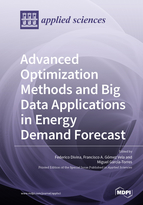Advanced Optimization Methods and Big Data Applications in Energy Demand Forecast
A special issue of Applied Sciences (ISSN 2076-3417). This special issue belongs to the section "Energy Science and Technology".
Deadline for manuscript submissions: closed (31 December 2020) | Viewed by 22341
Special Issue Editors
Interests: knowledge extraction; soft computing; high performance computing; data streaming
Special Issues, Collections and Topics in MDPI journals
Interests: computer vision; machine learning; image and signal processing; 5G communications; IoT
Special Issues, Collections and Topics in MDPI journals
Interests: machine learning; bioinformatics; astrostatistics; big data
Special Issues, Collections and Topics in MDPI journals
Special Issue Information
Dear Colleagues,
The growing utilization of data collectors in energy systems has resulted in the collection of a very high volume of data. For instance, smart sensors are now widely used in energy production and energy consumption systems. It follows that such Big Data allow a number of opportunities and challenges for informed decision-making.
Very powerful approaches have been developed in the context of data science and big data analytics in recent years. Such approaches deal with huge datasets, considering all samples and measurements, as well as including many additional features. With them, automated machine learning methods for extracting relevant patterns, high-performance computing or data visualization are now being successfully applied to energy demand forecasting.
The aim of this Special Issue is to gather the latest advancements in energy demand forecast, and in particular with the use of advanced optimization methods and Big Data techniques. Here, by energy, we mean any kind of energy, e.g., electrical, solar, microwave, wind.
We encourage researchers to share their original works in the fields of energy demand forecasting, with a particular emphasis on applications. Topics of primary interest include but are not limited to:
- Advanced optimization methods for energy demand forecast;
- Big Data techniques for energy demand forecast;
- Optimization methods and big data in energy-related time series forecasting;
- Optimization methods and big data in nonparametric time series approaches;
Prof. Dr. Federico Divina
Prof. Dr. Francisco A. Gómez Vela
Prof. Dr. Miguel García-Torres
Guest Editor
Manuscript Submission Information
Manuscripts should be submitted online at www.mdpi.com by registering and logging in to this website. Once you are registered, click here to go to the submission form. Manuscripts can be submitted until the deadline. All submissions that pass pre-check are peer-reviewed. Accepted papers will be published continuously in the journal (as soon as accepted) and will be listed together on the special issue website. Research articles, review articles as well as short communications are invited. For planned papers, a title and short abstract (about 100 words) can be sent to the Editorial Office for announcement on this website.
Submitted manuscripts should not have been published previously, nor be under consideration for publication elsewhere (except conference proceedings papers). All manuscripts are thoroughly refereed through a single-blind peer-review process. A guide for authors and other relevant information for submission of manuscripts is available on the Instructions for Authors page. Applied Sciences is an international peer-reviewed open access semimonthly journal published by MDPI.
Please visit the Instructions for Authors page before submitting a manuscript. The Article Processing Charge (APC) for publication in this open access journal is 2400 CHF (Swiss Francs). Submitted papers should be well formatted and use good English. Authors may use MDPI's English editing service prior to publication or during author revisions.








